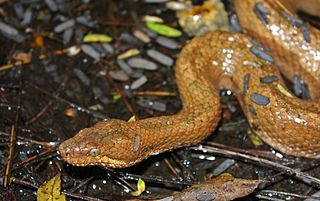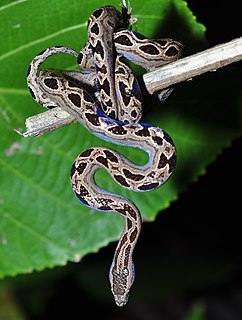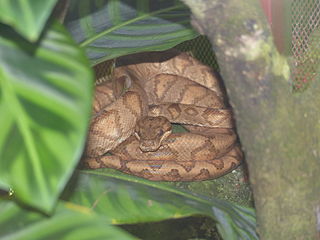
The Aniliidae are a monotypic family created for the monotypic genus Anilius that contains the single species A. scytale. Common names include American pipe snake and false coral snake. It is found in South America. This snake possesses a vestigial pelvic girdle that is visible as a pair of cloacal spurs. It is ovoviviparous. It is non-venomous, and its diet consists mainly of amphibians and other reptiles. Currently, two subspecies are recognized, including the typical form described here.
Amerotyphlops brongersmianus, known commonly as Brongersma's worm snake or the South American striped blindsnake, is a species of harmless blind snake in the family Typhlopidae. The species is found in South America and Trinidad and Tobago in the Caribbean. No subspecies are currently recognized.

The Tropidophiidae, common name dwarf boas or thunder snakes, are a family of nonvenomous snakes found from Mexico and the West Indies south to southeastern Brazil. These are small to medium-sized fossorial snakes, some with beautiful and striking color patterns. Currently, two living genera, containing 34 species, are recognized. Two other genera were once considered to be tropidophiids but are now known to be more closely related to boids, and are classified in the subfamily Ungaliophiinae. There are a relatively large number of fossil snakes that have been described as tropidophiids, but which of these are more closely related to Tropidophis and Trachyboa and which are more closely related to Ungaliophis and Exiliboa is unknown.

Bothrops leucurus, commonly known as the whitetail lancehead or the Bahia lancehead, is a species of venomous snake, a pit viper in the family Viperidae. The species is endemic to Brazil. There are no subspecies which are recognized as being valid. A female owned by youtuber Venom Central is over six feet long.

Leptotyphlops is a genus of nonvenomous blind snakes, commonly known as slender blind snakes and threadsnakes, in the family Leptotyphlopidae. The genus is endemic to and found throughout Africa. 11 species have been moved to the genus Trilepida, and other species have been moved to the genera Epacrophis, Epictia, Mitophis, Myriopholis, Namibiana, Rena, Siagonodon, Tetracheilostoma, and Tricheilostoma.

Ungaliophis is a genus of dwarf boas found from southern Mexico to Colombia. Currently, 2 species are recognized.
Anomalepis is a genus of nonvenomous blind snakes found in Central and South America. Currently, 4 monotypic species are recognized.
Helminthophis is a genus of non-venomous blind snakes found in southern Central America and northwestern South America. Currently, 3 monotypic species are recognized.

Porthidium lansbergii is a species of venomous snake, a pitviper in the family Viperidae. The species is endemic to Central and South America. Four subspecies are recognized, including the nominate subspecies described here.

Corallus annulatus is a non-venomous boa species found in Central and South America. Three subspecies are currently recognized, including the nominate subspecies described here.

Trachyboa boulengeri, commonly known as the northern eyelash boa, is a species of nonvenomous snake in the family Tropidophiidae. The species is endemic to Central America.
Bothrocophias colombianus, commonly known as the Colombian toad-headed pitviper, is a species of venomous snake in the family Viperidae. It is endemic to South America.
Bothrocophias microphthalmus, or the small-eyed toad-headed pit viper, is a species of venomous snake in the family Viperidae. The species is endemic to northwestern South America.

Bothrops venezuelensis, or the Venezuelan lancehead, is a species of venomous snake in the family Viperidae. It is endemic to South America.
Anomalepis colombia is a species of snake in the family Anomalepididae. It is endemic to Colombia and only known from the holotype collected in Caldas.
Joshua's blind snake is a species of snake in the family Leptotyphlopidae. The species is endemic to Colombia.
Dugand's blind snake is a species of snake in the family Leptotyphlopidae. The species is endemic to South America.
The Santander blind snake is a species of snake in the family Leptotyphlopidae. The species is endemic to Colombia.

Epictia goudotii, or the black blind snake, is a species of snake in the family Leptotyphlopidae. The species is endemic to Middle America.
Epictia signata, or the South American blind snake, is a species of snake in the family Leptotyphlopidae. The species is endemic to northwestern South America.










